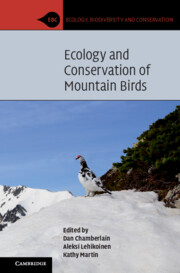Book contents
- Ecology and Conservation of Mountain Birds
- Ecology, Biodiversity and Conservation
- Ecology and Conservation of Mountain Birds
- Copyright page
- Contents
- Contributors
- Preface
- Acknowledgements
- 1 Mountain Birds and Their Habitats
- 2 Avian Adaptations to High Mountain Habitats
- 3 Global Bird Communities of Alpine and Nival Habitats
- 4 Birds of Treeline Ecotones
- 5 Population Trends of Mountain Birds in Europe and North America
- 6 Climate Change Impacts on Mountain Birds
- 7 Anthropogenic Activities and Mountain Birds
- 8 Modelling Large-Scale Patterns in Mountain Bird Diversity and Distributions
- 9 The Alpine Avifauna of Tropical Mountains
- 10 Priorities for Information, Research and Conservation of Birds in High Mountains
- Bird Species Index
- Subject Index
- Plate Section (PDF Only)
- References
1 - Mountain Birds and Their Habitats
Published online by Cambridge University Press: 30 June 2023
- Ecology and Conservation of Mountain Birds
- Ecology, Biodiversity and Conservation
- Ecology and Conservation of Mountain Birds
- Copyright page
- Contents
- Contributors
- Preface
- Acknowledgements
- 1 Mountain Birds and Their Habitats
- 2 Avian Adaptations to High Mountain Habitats
- 3 Global Bird Communities of Alpine and Nival Habitats
- 4 Birds of Treeline Ecotones
- 5 Population Trends of Mountain Birds in Europe and North America
- 6 Climate Change Impacts on Mountain Birds
- 7 Anthropogenic Activities and Mountain Birds
- 8 Modelling Large-Scale Patterns in Mountain Bird Diversity and Distributions
- 9 The Alpine Avifauna of Tropical Mountains
- 10 Priorities for Information, Research and Conservation of Birds in High Mountains
- Bird Species Index
- Subject Index
- Plate Section (PDF Only)
- References
Summary
There are many definitions of what is a ‘mountain’ and what is a ‘mountain bird’. In this chapter, we first assess these different definitions, and then clearly outline our rationale for choosing to define a mountain bird as bird species where at least some populations of the species somewhere in their distribution spend at least one critical stage of their life cycle above treeline. We then provide an overview of the importance of mountains to biodiversity, and compare knowledge on mountain birds to lowland ecosystems. Zonation is an important aspect of mountain ecology – we review the evidence for consistent patterns in bird richness and diversity across elevation gradients, and consider the different hypotheses that might explain these patterns. Additionally, we consider variation along the elevation gradient in some general species characteristics and the extent to which these trends vary geographically. Furthermore, we give an overview of how mountain bird communities vary seasonally, in particular considering different dispersal and migration strategies, and the extent to which the prevalence of these strategies varies according to different regions. Finally, we summarise the history of human interventions in mountains and their impacts on bird communities from pre-history until the start of the mechanized age.
Keywords
- Type
- Chapter
- Information
- Ecology and Conservation of Mountain Birds , pp. 1 - 34Publisher: Cambridge University PressPrint publication year: 2023



